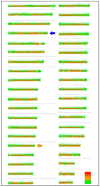Present and Future Salmonid Cytogenetics
- PMID: 33291343
- PMCID: PMC7762217
- DOI: 10.3390/genes11121462
Present and Future Salmonid Cytogenetics
Abstract
Salmonids are extremely important economically and scientifically; therefore, dynamic developments in their research have occurred and will continue occurring in the future. At the same time, their complex phylogeny and taxonomy are challenging for traditional approaches in research. Here, we first provide discoveries regarding the hitherto completely unknown cytogenetic characteristics of the Anatolian endemic flathead trout, Salmo platycephalus, and summarize the presently known, albeit highly complicated, situation in the genus Salmo. Secondly, by outlining future directions of salmonid cytogenomics, we have produced a prototypical virtual karyotype of Salmo trutta, the closest relative of S. platycephalus. This production is now possible thanks to the high-quality genome assembled to the chromosome level in S. trutta via soft-masking, including a direct labelling of repetitive sequences along the chromosome sequence. Repetitive sequences were crucial for traditional fish cytogenetics and hence should also be utilized in fish cytogenomics. As such virtual karyotypes become increasingly available in the very near future, it is necessary to integrate both present and future approaches to maximize their respective benefits. Finally, we show how the presumably repetitive sequences in salmonids can change the understanding of the overall relationship between genome size and G+C content, creating another outstanding question in salmonid cytogenomics waiting to be resolved.
Keywords: FISH; NOR phenotype; Salmo platycephalus; chromosome banding; cytotaxonomy of trout; rDNA.
Conflict of interest statement
The authors declare no conflict of interest. The funders had no role in the design of the study; in the collection, analyses, or interpretation of data; in the writing of the manuscript, or in the decision to publish the results.
Figures




Similar articles
-
Chromosomal study of native and hatchery trouts from Italy (Salmo trutta complex, Salmonidae): conventional and FISH analysis.Cytogenet Genome Res. 2009;124(1):51-62. doi: 10.1159/000200088. Epub 2009 Apr 15. Cytogenet Genome Res. 2009. PMID: 19372669
-
Chromosome relationships in the genus Salmo.Chromosoma. 1984;90(3):229-37. doi: 10.1007/BF00292401. Chromosoma. 1984. PMID: 6499596
-
Localization of the repetitive telomeric sequence (TTAGGG)n in four salmonid species.Genome. 1996 Oct;39(5):1035-8. doi: 10.1139/g96-129. Genome. 1996. PMID: 8890525
-
Chromosome evolution in the Salmonidae (Pisces): an update.Biol Rev Camb Philos Soc. 2001 Feb;76(1):1-25. doi: 10.1017/s1464793100005613. Biol Rev Camb Philos Soc. 2001. PMID: 11325050 Review.
-
Salmonidae Genome: Features, Evolutionary and Phylogenetic Characteristics.Genes (Basel). 2022 Nov 27;13(12):2221. doi: 10.3390/genes13122221. Genes (Basel). 2022. PMID: 36553488 Free PMC article. Review.
Cited by
-
On the Base Composition of Transposable Elements.Int J Mol Sci. 2022 Apr 26;23(9):4755. doi: 10.3390/ijms23094755. Int J Mol Sci. 2022. PMID: 35563146 Free PMC article. Review.
-
Revisiting the Karyotypes of Alligators and Caimans (Crocodylia, Alligatoridae) after a Half-Century Delay: Bridging the Gap in the Chromosomal Evolution of Reptiles.Cells. 2021 Jun 5;10(6):1397. doi: 10.3390/cells10061397. Cells. 2021. PMID: 34198806 Free PMC article.
-
Advances in Vertebrate (Cyto)Genomics Shed New Light on Fish Compositional Genome Evolution.Genes (Basel). 2023 Jan 17;14(2):244. doi: 10.3390/genes14020244. Genes (Basel). 2023. PMID: 36833171 Free PMC article.
-
Independent evolution of satellite DNA sequences in homologous sex chromosomes of Neotropical armored catfish (Harttia).Commun Biol. 2025 Mar 30;8(1):524. doi: 10.1038/s42003-025-07891-6. Commun Biol. 2025. PMID: 40159539 Free PMC article.
-
Abandoning the Isochore Theory Can Help Explain Genome Compositional Organization in Fish.Int J Mol Sci. 2023 Aug 24;24(17):13167. doi: 10.3390/ijms241713167. Int J Mol Sci. 2023. PMID: 37685974 Free PMC article.
References
-
- Delling B., Doario I. Systematics of the trouts endemic to Moroccan lakes, with description of a new species (Teleostei: Salmonidae) Ichthyol. Explor. Freshw. 2005;16:49–64.
-
- Doadrio I., Perea S., Yahyaoui A. Two new species of atlantic trout (Actynopterygii, Salmonidae) from Morocco. Graellsia. 2015;71:e031. doi: 10.3989/graellsia.2015.v71.142. - DOI
-
- Doadrio I. Ictiofauna Continental Española: Bases Para Su Seguimiento. Ministerio de Medio Ambiente y Medio Rural y Marino, Centro de Publicaciones; Madrid, Spain: 2011.
-
- Kottelat M., Freyhof J. Handbook of European Freshwater Fishes. Publications Kottelat; Cornol, Switzerland: 2007.
-
- Delling B. Diversity of western and southern Balkan trouts, with the description of a new species from the Louros River, Greece (Teleostei: Salmonidae) Ichthyol. Explor. Freshw. 2010;21:331.
Publication types
MeSH terms
LinkOut - more resources
Full Text Sources
Research Materials

